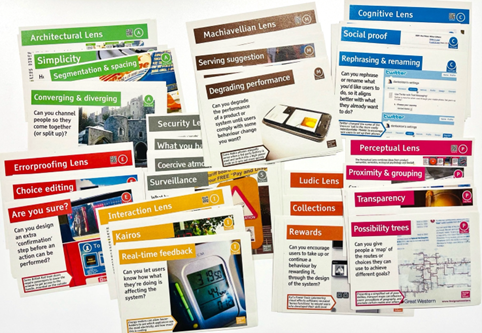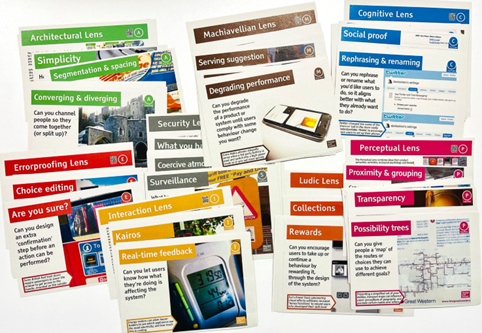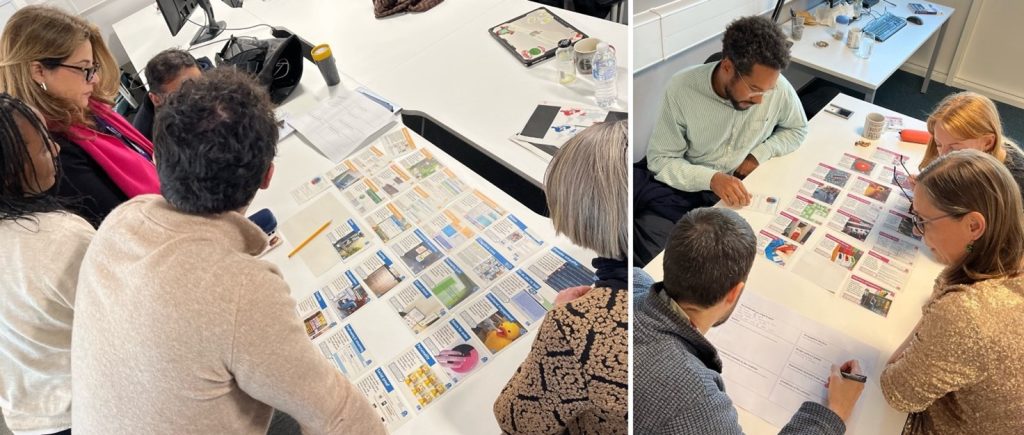
- Date
- 18th February 2025
- Categories
- Cooking Appliances
By Dr Aine Petrulaityte
The transition to clean, modern cooking requires behaviour change. Today, those interested in making behaviour-change interventions can access numerous existing methods and tools or even create their own using 93 behaviour-change techniques identified by the Centre of Behaviour Change. Clean cooking experts have developed frameworks relevant to the field, such as the Clean cooking intervention framework and the Behaviour change framework for the clean cooking sector, while others applied already established methods, such as the Behaviour-Centred Design approach.
As a sustainability-focused design researcher, I happen to have a favourite behaviour change tool – Design with Intent. Developed by Dan Lockton, this toolkit consists of a deck of 101 design patterns that serve as an inspiration guide for creating behaviour change interventions across products, services, and environments. These patterns are grouped into eight ‘lenses’ that enable users to think about behaviour change from different perspectives (e.g., the Machiavellian lens encourages unethical interventions, while the Ludic lens suggests using game elements, etc.) Each card includes a provocative question and an example of particular principles in action, inviting a discussion about behaviour change.

The Design with Intent toolkit was not designed with a specific sector in mind, and I could not find evidence of its prior use in clean cooking. Therefore, I was eager to test its potential for generating solutions within the MECS Program.
To achieve this, I organised an idea-generation workshop with 18 members of the MECS team, divided into four groups, each assigned a user persona based on real data gathered from interviews with clean cooking companies. Each group received two ‘lenses’ containing 24 to 27 design pattern cards and a simplified problem-solution fit canvas to document their ideas. Their task was to develop a solution that would shift the persona’s behaviour towards adopting eCooking, whether partially or completely. Teams had 45 minutes to review the cards, brainstorm, and refine their solutions, after which they presented their proposed interventions.

Below I present the solutions my colleagues developed for each of the four personas summarising their ideas triggered by specific design patterns.
Team I: A gamified EPC for a young rice cooker user who wants to cook everything without having to constantly monitor the food.
- Persona’s goals: To be able to use only electricity for cooking, not having to switch to charcoal and LPG.
- Persona’s needs: She needs to feed the family of 4 as quickly as possible.
- Persona’s frustrations: She is bored with cooking the same meals every day and not knowing how to cook new dishes.
The team worked with the Machiavellian and Ludic lenses to encourage the persona’s transition to entirely eCooking while addressing her need for variety and speed. For the Machiavellian lens, it prompted them to consider tackling rice packets which could include vegetables and be paired with recipe cards. Admittedly this idea was inspired because such packets already exist in developed economies, however, this idea creates a local industry packing pre-prepared food. In this way, they could simplify meal preparation and introduce diverse dishes, knowing user’s frustration with repetitive meals. To incentivise the use of an EPC, the Ludic lens inspired features like “Cooking Bingo” and streak-based rewards: cooking dishes presented on the recipe cards unlocks discounts on other cooking appliances like induction cookstoves and air fryers or free cookware. These ideas align with the design patterns of Bundling and Serving suggestions and encourage the adoption of additional appliances for the transition to entirely electric cooking. The EPC first comes with limited features and incorporates functional obsolescence, which includes unlockable features for product upgrades.
Team II: A secure multi-cooker for a student living outside of halls who wants to look innovative and modern and stay away from the ‘cooking like a grandma’ vibe.
- Persona’s goals: To have one cooking appliance for all his cooking and lifestyle needs.
- Persona’s needs: To cook as cheaply as possible.
- Persona’s frustrations: Finding personal stuff, including household appliances, used and mishandled by flatmates.
The team used the Architectural and Security lenses to address ownership, affordability, and accountability of appliances used in shared living spaces. Their solution is a multi-functional, energy-efficient appliance, similar to a Ninja 4-in-1 cooker, which combines modern design with cost-effectiveness. Aligned with the What you have and Who or what you are design patterns, the solution incorporates a biometric scan to restrict usage to its authorised owner. This idea was expanded into a cooking device-sharing app for cost-sharing among verified housemates. It also includes a mandatory behaviour test and interactive guide that must be completed to activate the appliance: e.g., users learn that metal cooking utensils cannot be used. The multi-cooker integrates energy-saving features such as buzzes and timers to optimise heat levels, inspired by the Simplicity design pattern.
Team III: An “Expert’s Choice” campaign for an electrified charcoal user who is willing to switch only if she sees a notable difference in price and speed.
- Persona’s goals: To have a mean of cooking which is fast, efficient and versatile.
- Persona’s needs: To be able to use existing cookware and cooking space.
- Persona’s frustrations: She is tired of having to babysit the food when it’s cooking to keep it from getting burned.
The team received the Cognitive and Interaction lenses. Their core idea is a behaviour change campaign for an EPC, highlighting it as a fast, efficient, and versatile product which can be used in an existing cooking space. Inspired by the design patterns Social proof, Expert choice, and Habits, a targeted campaign demonstrates how traditional dishes can be prepared in the EPC, featuring expert endorsements and eCookbooks with culture-specific recipes. In line with Real-time feedback and Simulation & feedforward design patterns, the integrated smart meter ensures the user no longer needs to supervise her food, saving time and preventing overcooking. In addition, the team considered potential barriers like habit change and upfront costs, which are addressed by emphasising long-term savings and ease of use, while demonstrating the product’s advantages through Summary feedback and Peer feedback.
Team IV: An all-inclusive solar EPC for an environmentally conscious off-grid user who can’t afford meat, so she only cooks pulses and cereals for her family, which takes a lot of time.
- Persona’s goals: To cook as cleanly as possible without having to spend too much time learning new tricks.
- Persona’s needs: To be able to choose appliances of well-known and reliable brands.
- Persona’s frustrations: None of the home appliances come with after-sales service, and no one can help when they malfunction.
The team used the Error proofing and Perceptual lenses to highlight a simple, reliable, and clean cooking experience. Their core product is a solar-powered EPC designed for a sunny rural Laos PDR. Priced competitively (similar to a smartphone), the solution prioritises low-income, off-grid users inspired by the offerings by Kachione in Malawi.The EPC is made to resemble a shiny eWant with LED indicators, reducing the learning curve through Mimicry and Mirroring design patterns. To build trust and address frustrations with after-sales service, the product is offered by a well-known brand with IoT-enabled support for remote troubleshooting and maintenance (the appliance should undergo regular revisions every six months to ensure high performance). The EPC includes dedicated buttons for cooking pulses and cereals inspired by Defaults and Perceived affordances. Aligned with Conditional warnings and Choice editing design patterns, it includes a basic on/off switch, a dial to adjust the simmer level, and a conditional warning system that automatically lowers the heat if left idle for five minutes.
I’ve run many design and idea-generation workshops in the past, and this time, I was very pleased to see that the MECS team generated so many ideas in just 45 minutes. The toolkit proved to be intuitive, and the room was filled with lively discussions. We also demonstrated that the Design with Intent toolkit could inspire diverse ideas in clean cooking: the solutions ranged from an existing eCooking appliance upgrade (an EPC) and a new product (a versatile multi-cooker) to an awareness-raising campaign. The activity demonstrated that the MECS team performs not only in data collection, international relations, and project management but also in on-the-spot creative problem-solving.
***************************************************************************************************************
Featured Image: Design with Intent toolkit: design patterns grouped into eight lenses. Photo credit: Aine Petrulaityte 2024.